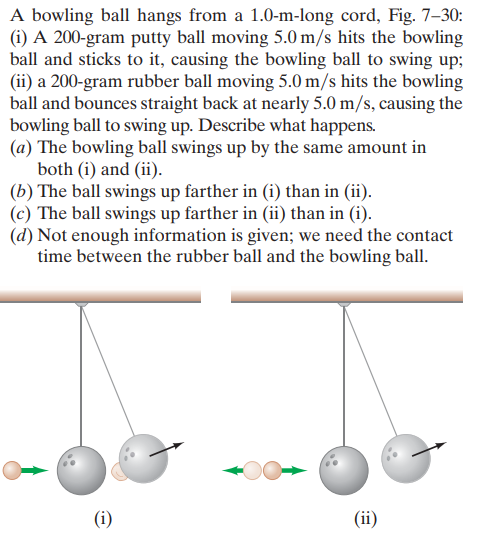A bowling ball hangs from a 1.0-m-long cord, Fig. 7–30: (i) A 200-gram putty ball moving 5.0 m/s hits the bowling ball and sticks to it, causing the bowling ball to swing up; (ii) a 200-gram rubber ball moving 5.0 m/s hits the bowling ball and bounces straight back at nearly 5.0 m/s, causing the bowling ball to swing up. Describe what happens. (a) The bowling ball swings up by the same amount in both (i) and (ii). (b) The ball swings up farther in (i) than in (ii). (c) The ball swings up farther in (ii) than in (i). (d) Not enough information is given; we need the contact time between the rubber ball and the bowling ball. (i) (ii)
A bowling ball hangs from a 1.0-m-long cord, Fig. 7–30: (i) A 200-gram putty ball moving 5.0 m/s hits the bowling ball and sticks to it, causing the bowling ball to swing up; (ii) a 200-gram rubber ball moving 5.0 m/s hits the bowling ball and bounces straight back at nearly 5.0 m/s, causing the bowling ball to swing up. Describe what happens. (a) The bowling ball swings up by the same amount in both (i) and (ii). (b) The ball swings up farther in (i) than in (ii). (c) The ball swings up farther in (ii) than in (i). (d) Not enough information is given; we need the contact time between the rubber ball and the bowling ball. (i) (ii)
University Physics Volume 1
18th Edition
ISBN:9781938168277
Author:William Moebs, Samuel J. Ling, Jeff Sanny
Publisher:William Moebs, Samuel J. Ling, Jeff Sanny
Chapter9: Linear Momentum And Collisions
Section: Chapter Questions
Problem 42P: A 2000-kg railway freight car coasts at 4.4 m/s underneath a grain terminal, which dumps grain...
Related questions
Question

Transcribed Image Text:A bowling ball hangs from a 1.0-m-long cord, Fig. 7–30:
(i) A 200-gram putty ball moving 5.0 m/s hits the bowling
ball and sticks to it, causing the bowling ball to swing up;
(ii) a 200-gram rubber ball moving 5.0 m/s hits the bowling
ball and bounces straight back at nearly 5.0 m/s, causing the
bowling ball to swing up. Describe what happens.
(a) The bowling ball swings up by the same amount in
both (i) and (ii).
(b) The ball swings up farther in (i) than in (ii).
(c) The ball swings up farther in (ii) than in (i).
(d) Not enough information is given; we need the contact
time between the rubber ball and the bowling ball.
(i)
(ii)
Expert Solution
This question has been solved!
Explore an expertly crafted, step-by-step solution for a thorough understanding of key concepts.
This is a popular solution!
Trending now
This is a popular solution!
Step by step
Solved in 5 steps with 4 images

Recommended textbooks for you

University Physics Volume 1
Physics
ISBN:
9781938168277
Author:
William Moebs, Samuel J. Ling, Jeff Sanny
Publisher:
OpenStax - Rice University

Glencoe Physics: Principles and Problems, Student…
Physics
ISBN:
9780078807213
Author:
Paul W. Zitzewitz
Publisher:
Glencoe/McGraw-Hill

University Physics Volume 1
Physics
ISBN:
9781938168277
Author:
William Moebs, Samuel J. Ling, Jeff Sanny
Publisher:
OpenStax - Rice University

Glencoe Physics: Principles and Problems, Student…
Physics
ISBN:
9780078807213
Author:
Paul W. Zitzewitz
Publisher:
Glencoe/McGraw-Hill